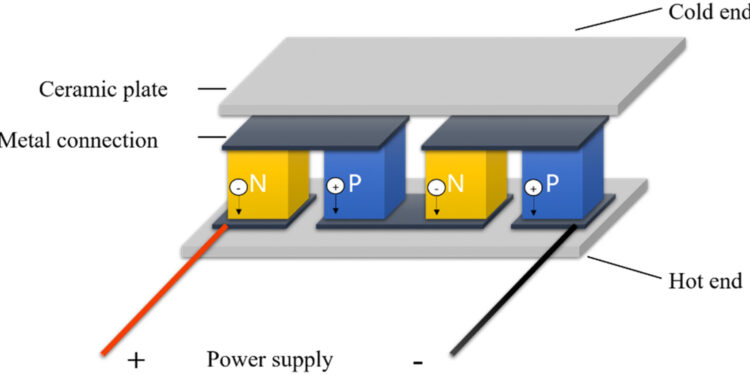Key Takeaways
Thermoelectric coolers are a compelling alternative to traditional cooling methods, offering efficiency, durability, and environmental responsibility. By harnessing the Peltier effect, they can efficiently manage temperatures without the harmful impact of refrigerants, offering an environmentally friendly solution that spans multiple industries. As a reflection of a broader shift towards sustainable practices, thermoelectric coolers symbolize the future of green technology in cooling systems.
Introduction to Thermoelectric Coolers
In today’s world, there is a profound drive towards adopting technologies that minimize environmental impacts while maintaining high performance standards. Thermoelectric coolers have emerged as an innovative component of this movement, marrying the principles of physics with modern engineering to offer an efficient, eco-friendly cooling solution. These devices leverage the Peltier effect, where heat transfer is achieved through electric currents, allowing temperature management without needing environmentally detrimental refrigerants. The thermoelectric cooler thus represents a significant stride towards sustainable innovation, meeting the global demand for technologies that support efforts against climate change. This paradigm shift highlights advancements in cooling systems and underscores a larger commitment to integrating sustainable practices into everyday technology.
Eco-Friendly Benefits of Thermoelectric Coolers
Thermoelectric coolers provide numerous benefits from an environmental perspective, primarily due to their revolutionary design. The absence of traditional refrigerants significantly minimizes the release of greenhouse gases, which are a primary contributor to global warming. Additionally, the solid-state design of these coolers eliminates mechanical components that are prone to wear and contribute to electronic waste, offering a sustainable advantage with a longer lifespan and less maintenance requirement. This approach aligns with initiatives outlined by Energy.gov, where integrating technologies with superior reliability and reduced environmental footprint can significantly contribute to conservation efforts. As industries increasingly prioritize sustainable practices, thermoelectric coolers are recognized for their potential in supporting eco-friendly transformations.
Energy Efficiency in Cooling
One critical strength of thermoelectric coolers is their enhanced energy efficiency, a pivotal concern in today’s energy-conscious environment. These coolers utilize precise electrical currents to manage temperatures, ensuring that energy consumption is optimized, unlike the continuous power draw necessary for traditional systems. This precise control lowers operational costs and minimizes energy waste, contributing to overall sustainability efforts. The International Energy Agency’s report highlights increasing energy efficiency as an essential strategy for developing sustainable global energy systems. Technologies like thermoelectric cooling are pivotal in meeting this objective, helping to pave the way towards a future where energy is utilized more sustainably and responsibly.
Comparison with Traditional Cooling Methods
While traditional cooling systems have dominated the market for years, their environmental impact and operational limitations have prompted a critical reassessment of their sustainability credentials. These conventional systems often involve compressors and chemical refrigerants that are both energy-intensive and harmful to the ozone layer. In contrast, thermoelectric coolers present a modern alternative that operates without these components, offering versatility and a cleaner, quieter operation that integrates seamlessly with today’s demanding environments. This distinct advantage provides a compelling case for replacing outdated systems, meeting the needs of contemporary consumers and industries that demand both functionality and environmental stewardship. As expectations for more sustainable cooling solutions grow, thermoelectric technology offers an adaptable solution poised to meet evolving demands.
Applications and Environmental Impact
Thermoelectric coolers have found applications across various industries, highlighting their versatility and potential for reducing environmental impact. In consumer electronics, they provide efficient, quiet cooling essential for maintaining high performance in today’s sophisticated devices. In sectors such as healthcare and pharmaceuticals, their use is crucial for maintaining the integrity of sensitive materials in environmentally controlled conditions. By providing reliable temperature management without harmful emissions, these coolers support industries in their efforts to comply with environmental regulations and sustainability goals. The adaptability and green benefits of thermoelectric cooling underscore a significant trend towards more ecologically responsible industrial practices, driving the agenda for sustainable development in various sectors.
Future Prospects for Eco-Friendly Cooling
The future outlook for thermoelectric cooling technology is bright, driven by ongoing research and innovation focused on enhancing efficiency and broadening applications. Advances in materials science are expected to increase these coolers’ efficiency and cost-effectiveness, paving the way for their greater integration across different industries. As these devices become more affordable and efficient, their potential to replace traditional cooling systems will expand. This shift reflects a commitment to sustainable technologies and aligns with global imperatives to reduce carbon footprints and foster more environmentally conscious industrial practices. The evolution of thermoelectric technologies is likely to play an integral role in meeting future cooling demands in an eco-friendly manner, supporting overarching climate goals.
Challenges and Limitations
Despite their advantages, thermoelectric coolers face challenges that must be addressed to realize their potential fully. When applied on a larger scale compared to traditional systems, current inefficiencies can limit their suitability for specific applications; these inefficiencies are a primary focus of ongoing research to improve future performance. Additionally, the initial costs due to specialized materials can discourage widespread adoption. Addressing these challenges requires continued investment in research and development to enhance scalability and reduce costs. As these technologies advance, the obstacles are expected to diminish, resulting in broader acceptance and utilization of thermoelectric coolers in environmentally sustainable processes across more sectors.
Conclusion: The Role of Thermoelectric Coolers in Sustainable Cooling
In conclusion, thermoelectric coolers offer a promising alternative in eco-friendly cooling technologies. Combining innovative mechanisms with a focus on reducing environmental impact aligns well with contemporary sustainability initiatives and forward-thinking industrial practices. As these coolers continue to evolve, they hold the potential to become central to future climate strategies, offering viable solutions that prioritize energy efficiency and environmental conservation. Embracing thermoelectric technology is a proactive step towards achieving a balanced approach to technological progress and ecological responsibility, contributing to the overarching goal of a more sustainable and resilient global future.








